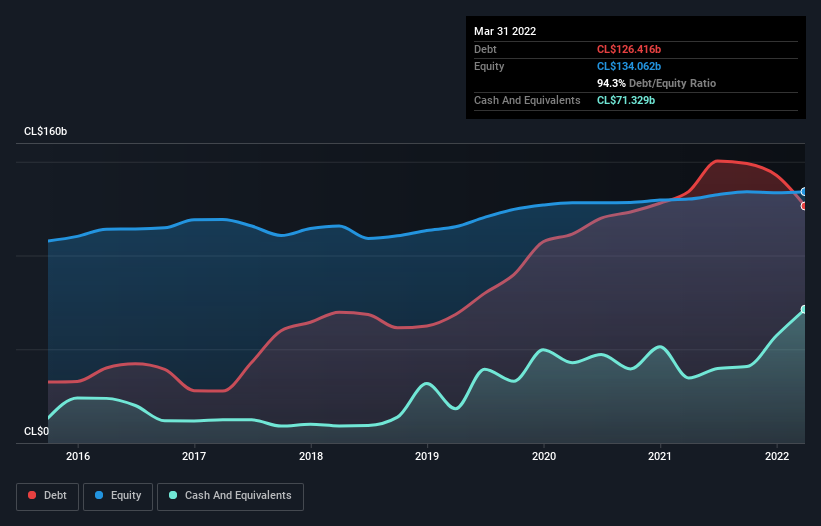- Chile
- /
- Construction
- /
- SNSE:EISA
These 4 Measures Indicate That Echeverría Izquierdo (SNSE:EISA) Is Using Debt Extensively
Warren Buffett famously said, 'Volatility is far from synonymous with risk.' It's only natural to consider a company's balance sheet when you examine how risky it is, since debt is often involved when a business collapses. Importantly, Echeverría Izquierdo S.A. (SNSE:EISA) does carry debt. But the more important question is: how much risk is that debt creating?
Why Does Debt Bring Risk?
Debt assists a business until the business has trouble paying it off, either with new capital or with free cash flow. Part and parcel of capitalism is the process of 'creative destruction' where failed businesses are mercilessly liquidated by their bankers. While that is not too common, we often do see indebted companies permanently diluting shareholders because lenders force them to raise capital at a distressed price. By replacing dilution, though, debt can be an extremely good tool for businesses that need capital to invest in growth at high rates of return. When we examine debt levels, we first consider both cash and debt levels, together.
Check out our latest analysis for Echeverría Izquierdo
What Is Echeverría Izquierdo's Net Debt?
You can click the graphic below for the historical numbers, but it shows that Echeverría Izquierdo had CL$126.4b of debt in March 2022, down from CL$134.1b, one year before. However, it also had CL$71.3b in cash, and so its net debt is CL$55.1b.

A Look At Echeverría Izquierdo's Liabilities
The latest balance sheet data shows that Echeverría Izquierdo had liabilities of CL$245.1b due within a year, and liabilities of CL$58.1b falling due after that. Offsetting this, it had CL$71.3b in cash and CL$35.8b in receivables that were due within 12 months. So its liabilities outweigh the sum of its cash and (near-term) receivables by CL$196.1b.
This deficit casts a shadow over the CL$43.6b company, like a colossus towering over mere mortals. So we'd watch its balance sheet closely, without a doubt. After all, Echeverría Izquierdo would likely require a major re-capitalisation if it had to pay its creditors today.
In order to size up a company's debt relative to its earnings, we calculate its net debt divided by its earnings before interest, tax, depreciation, and amortization (EBITDA) and its earnings before interest and tax (EBIT) divided by its interest expense (its interest cover). Thus we consider debt relative to earnings both with and without depreciation and amortization expenses.
While we wouldn't worry about Echeverría Izquierdo's net debt to EBITDA ratio of 4.0, we think its super-low interest cover of 2.2 times is a sign of high leverage. It seems clear that the cost of borrowing money is negatively impacting returns for shareholders, of late. Looking on the bright side, Echeverría Izquierdo boosted its EBIT by a silky 37% in the last year. Like a mother's loving embrace of a newborn that sort of growth builds resilience, putting the company in a stronger position to manage its debt. There's no doubt that we learn most about debt from the balance sheet. But you can't view debt in total isolation; since Echeverría Izquierdo will need earnings to service that debt. So when considering debt, it's definitely worth looking at the earnings trend. Click here for an interactive snapshot.
Finally, a business needs free cash flow to pay off debt; accounting profits just don't cut it. So it's worth checking how much of that EBIT is backed by free cash flow. Happily for any shareholders, Echeverría Izquierdo actually produced more free cash flow than EBIT over the last three years. That sort of strong cash conversion gets us as excited as the crowd when the beat drops at a Daft Punk concert.
Our View
While Echeverría Izquierdo's level of total liabilities has us nervous. For example, its conversion of EBIT to free cash flow and EBIT growth rate give us some confidence in its ability to manage its debt. When we consider all the factors discussed, it seems to us that Echeverría Izquierdo is taking some risks with its use of debt. So while that leverage does boost returns on equity, we wouldn't really want to see it increase from here. When analysing debt levels, the balance sheet is the obvious place to start. However, not all investment risk resides within the balance sheet - far from it. These risks can be hard to spot. Every company has them, and we've spotted 4 warning signs for Echeverría Izquierdo (of which 1 is concerning!) you should know about.
Of course, if you're the type of investor who prefers buying stocks without the burden of debt, then don't hesitate to discover our exclusive list of net cash growth stocks, today.
Valuation is complex, but we're here to simplify it.
Discover if Echeverría Izquierdo might be undervalued or overvalued with our detailed analysis, featuring fair value estimates, potential risks, dividends, insider trades, and its financial condition.
Access Free AnalysisHave feedback on this article? Concerned about the content? Get in touch with us directly. Alternatively, email editorial-team (at) simplywallst.com.
This article by Simply Wall St is general in nature. We provide commentary based on historical data and analyst forecasts only using an unbiased methodology and our articles are not intended to be financial advice. It does not constitute a recommendation to buy or sell any stock, and does not take account of your objectives, or your financial situation. We aim to bring you long-term focused analysis driven by fundamental data. Note that our analysis may not factor in the latest price-sensitive company announcements or qualitative material. Simply Wall St has no position in any stocks mentioned.
About SNSE:EISA
Echeverría Izquierdo
Engages in the engineering and construction activities in Chile.
Solid track record average dividend payer.
Similar Companies
Market Insights
Community Narratives




